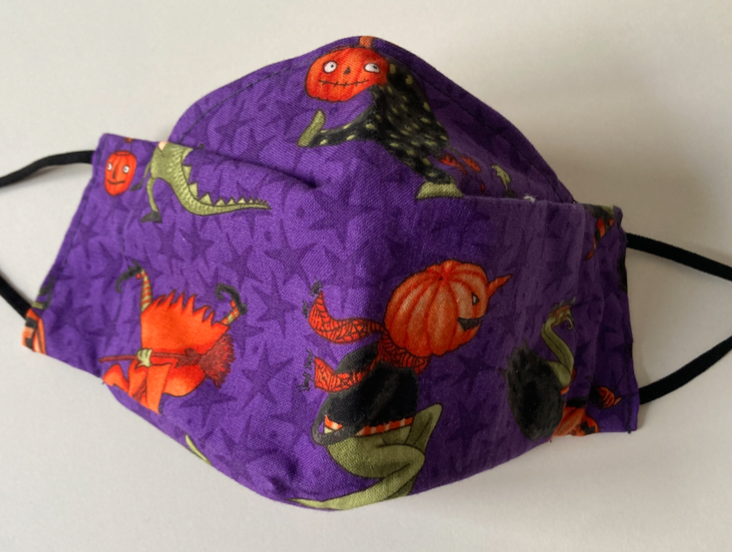Sourcing and Selecting Fabric
Browsing fabrics can be part of the fun of making face masks. Here are a few pointers on where to shop and what to look for.
Sourcing and Selecting Fabrics
Browsing for fabrics is part of the fun of making masks. Read on for some pointers on sourcing and selecting appropriate fabrics.
Prints
My preference is for a busy, allover print for 3D masks. It helps to hide imperfections in your stitching or any wonkiness in the shape. I prefer smaller scale prints, since the masks are small and over-large motifs don’t show well, especially since parts of the fabric are hidden in the folds. Fabrics with a subtle tone-on-tone print, sometimes described as “blenders,” provide some visual interest without making too bold a statement with a print, and also help to conceal imperfections.
I avoid bold geometric or linear prints or very symmetrical designs that require precise pattern placement. Quilting cottons can be printed irritatingly off-grain, and I don’t want to work too hard to have everything perfectly lined up. I’ve also learned to avoid “toss” prints, where a motif is oriented in different directions. Those are fine for a quilt, but on my face, it seems no matter how carefully I place my pattern, something upside-down becomes a focal point. If you’re making one mask at a time, this sort of issue may not be a deal-breaker for you, but if you’re sewing big batches, it helps to not have to worry too much about pattern placement.

Abstract, colorful prints are fun and conceal mistakes.

Fabric lines often include different colorways of the same prints.

Prints known as "blenders" come in a rainbow of colors.

Metallics add further interest while keeping a subtly textured appearance.

Smaller scale prints, such as the ditsy florals on the right, tend to fit the masks better than large scale prints.

A bundle of batiks such as this offers a variety of colors and prints, some easier to work with than others.

Linear or symmetrical prints can look nice, but it can be an added challenge to line everything up correctly.

A simple search like "butterflies" yields endless results.

"Toss" prints can seem like nothing is right-side up.

This mask has a few strikes against it: the large-scale print doesn't fit well on the mask, some of the figures appear upside-down, and worst of all there's a pair of eyes right on the bridge of the nose.

These child-size masks were much more successful with the smaller scale of this print collection.
Sources
If you have a local fabric store you can patronize in person, by all means shop there. Not only will you support a local business, you’ll also better be able to judge the quality and suitability of the fabric for your purposes. Nothing beats seeing and feeling the fabric in person, especially if you are coordinating or matching fabrics and threads.
If you don’t have a good fabric shop in your area, or there are other obstacles to shopping in person, there are a number of sources for purchasing online. I have found that the bigger online fabric retailers often have a minimum size cut of one to two yards, which is usually more than I like to purchase. Also, the time to ship can vary widely, especially with Covid protocols. Because of this, I tend to browse the shops on Etsy. If you’re unfamiliar, Etsy is a marketplace where you are buying from independent sellers who have their own inventory and shop policies and ship from their own locations. In my experience, sellers on Etsy tend to be responsive to questions and to ship quickly. But be sure to check the store’s policies and read reviews before ordering. You can use the search filters to look for sellers in your country or state, or other factors that may be important to you when choosing a seller to patronize.
But where to start on your online search for fabric? You can start with something as vague as “Fat Quarters” or “Quilting Cotton”, which will return an overwhelming number of results. You can narrow it down to a favorite color, print, or theme. Some sellers will curate a bundle of fat quarters along a theme or color, and that could be an easy way to get started. If you’re feeling adventurous, you could buy a scrap pack or surprise bundle, but pay attention to the minimum size of the pieces included to be sure they’ll be big enough for your masks.
A couple of things to keep in mind: Some Etsy sellers have noted that the platform doesn’t always calculate shipping for multiple items correctly. Sellers will often refund shipping overages, but if you’re not sure and shipping seems high, be sure to ask them. If you choose fabrics from different sellers, your purchases will be subject to shipping charges from each seller. Many sellers will offer free shipping after a minimum purchase is met, but that only includes purchases from that individual shop. I tend to browse Etsy as a whole until I find something that catches my eye, then look through that seller’s other items to round out my purchase.
